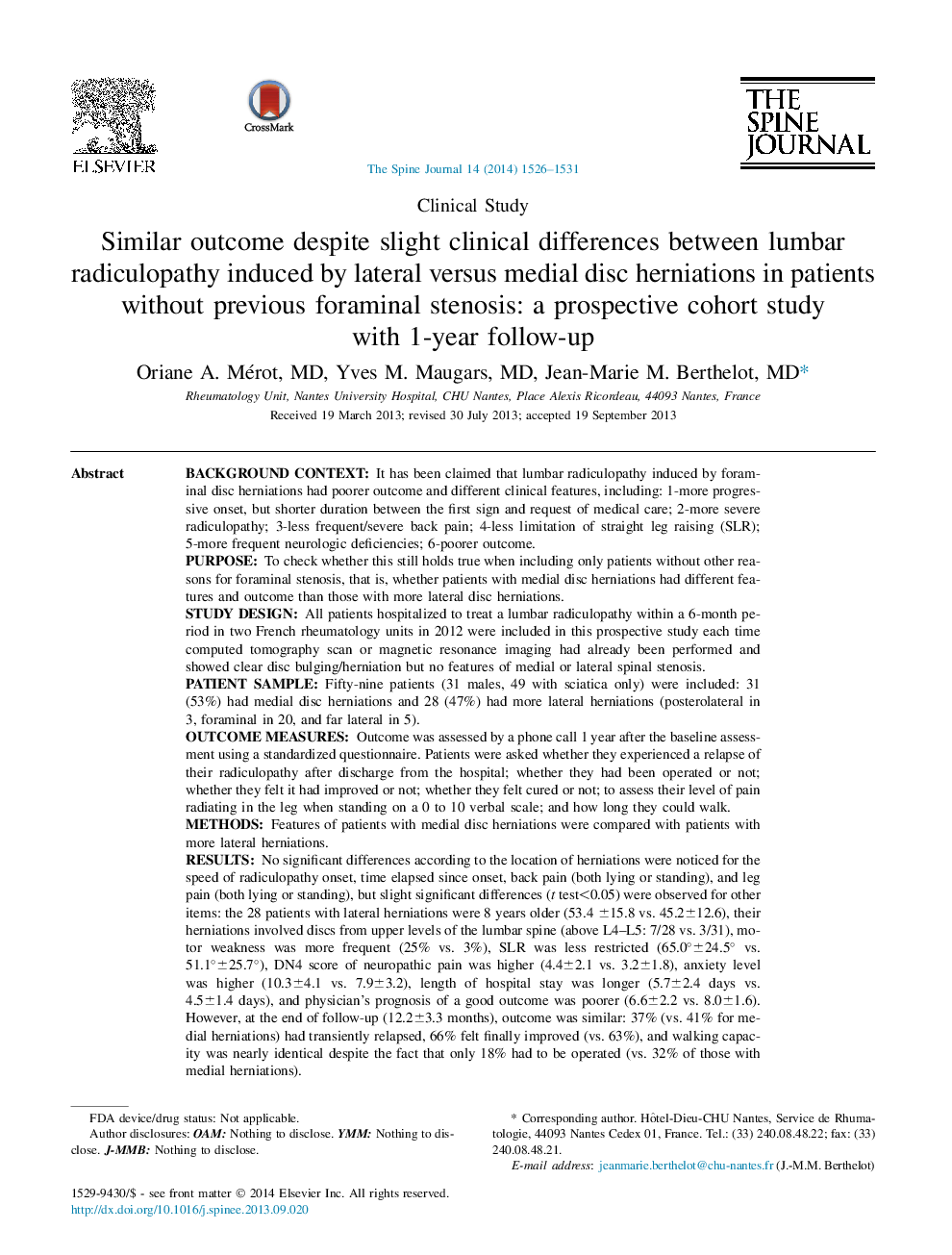| کد مقاله | کد نشریه | سال انتشار | مقاله انگلیسی | نسخه تمام متن |
|---|---|---|---|---|
| 6212201 | 1268575 | 2014 | 6 صفحه PDF | دانلود رایگان |

Background contextIt has been claimed that lumbar radiculopathy induced by foraminal disc herniations had poorer outcome and different clinical features, including: 1-more progressive onset, but shorter duration between the first sign and request of medical care; 2-more severe radiculopathy; 3-less frequent/severe back pain; 4-less limitation of straight leg raising (SLR); 5-more frequent neurologic deficiencies; 6-poorer outcome.PurposeTo check whether this still holds true when including only patients without other reasons for foraminal stenosis, that is, whether patients with medial disc herniations had different features and outcome than those with more lateral disc herniations.Study designAll patients hospitalized to treat a lumbar radiculopathy within a 6-month period in two French rheumatology units in 2012 were included in this prospective study each time computed tomography scan or magnetic resonance imaging had already been performed and showed clear disc bulging/herniation but no features of medial or lateral spinal stenosis.Patient sampleFifty-nine patients (31 males, 49 with sciatica only) were included: 31 (53%) had medial disc herniations and 28 (47%) had more lateral herniations (posterolateral in 3, foraminal in 20, and far lateral in 5).Outcome measuresOutcome was assessed by a phone call 1 year after the baseline assessment using a standardized questionnaire. Patients were asked whether they experienced a relapse of their radiculopathy after discharge from the hospital; whether they had been operated or not; whether they felt it had improved or not; whether they felt cured or not; to assess their level of pain radiating in the leg when standing on a 0 to 10 verbal scale; and how long they could walk.MethodsFeatures of patients with medial disc herniations were compared with patients with more lateral herniations.ResultsNo significant differences according to the location of herniations were noticed for the speed of radiculopathy onset, time elapsed since onset, back pain (both lying or standing), and leg pain (both lying or standing), but slight significant differences (t test<0.05) were observed for other items: the 28 patients with lateral herniations were 8 years older (53.4 ±15.8 vs. 45.2±12.6), their herniations involved discs from upper levels of the lumbar spine (above L4-L5: 7/28 vs. 3/31), motor weakness was more frequent (25% vs. 3%), SLR was less restricted (65.0°±24.5° vs. 51.1°±25.7°), DN4 score of neuropathic pain was higher (4.4±2.1 vs. 3.2±1.8), anxiety level was higher (10.3±4.1 vs. 7.9±3.2), length of hospital stay was longer (5.7±2.4 days vs. 4.5±1.4 days), and physician's prognosis of a good outcome was poorer (6.6±2.2 vs. 8.0±1.6). However, at the end of follow-up (12.2±3.3 months), outcome was similar: 37% (vs. 41% for medial herniations) had transiently relapsed, 66% felt finally improved (vs. 63%), and walking capacity was nearly identical despite the fact that only 18% had to be operated (vs. 32% of those with medial herniations).ConclusionsDespite differences in clinical presentation, the outcome of radiculopathy induced by the more lateral lumbar disc herniations was not worse than the outcome of patients with only medial disc herniations. Previous claims of poorer outcome in foraminal herniations might be explained by the inclusion of patients with associated foraminal stenosis.
Journal: The Spine Journal - Volume 14, Issue 8, 1 August 2014, Pages 1526-1531